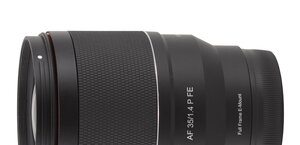Sony E 18-55 mm f/3.5-5.6 OSS
11. Summary
- very good image resolution in the frame centre,
- well-controlled chromatic aberration at the maximum aperture,
- image stabilization at the level of 2EV,
- good coma control.
Cons:
- weak or momentarily very weak resolution on the edge of the frame,
- bad work against bright light,
- very high chromatic aberration at shorter focal lengths,
- significant distortion,
- noticeable vignetting at the widest angle of view.
We were very curious about the results of the tested Sony E 18–55 mm f/3.5–5.6 OSS. After all it is the first NEX system kit lens and the only zoom model among two lenses currently available in this system. Certainly it will be the lens the most often attached to NEX-3 and NEX-5 cameras for some time; this instruments must bear heavy responsibility for setting the quality for the whole system. Apart from a group of users who might buy a NEX because of its pancake lens or because of other systems’ lenses which can be attached using a converter, no experienced amateur photographer will purchase consciously even the best camera if the only kit lens available gives you bad image quality.
Please Support UsIf you enjoy our reviews and articles, and you want us to continue our work please, support our website by donating through PayPal. The funds are going to be used for paying our editorial team, renting servers, and equipping our testing studio; only that way we will be able to continue providing you interesting content for free. |
- - - - - - - - - - - - - - - - - - - - - - - - - - - - - - - - - - - - - - - - - - - - - - - -
Does the tested Sony can play its part well? Consulting the test results, presented on the previous pages, you can have, unfortunately, mixed feelings. There are categories in which the Sony E 18–55 f/3.5–5.6 OSS fares really well – very good resolution in the frame centre, a decent stabilization level or good control of the coma. An accurate autofocus is hardly the advantage of a lens used on cameras with contrast detection system but nevertheless it is a valuable merit of the system as a whole.
The list of the tested lens’s flaws is regrettably quite long too. In some categories its results can be only called a spectacular slip-up. We think here mainly about the weak work against bright light and the high level of chromatic aberration. Also the frame edge resolution leaves a lot to be desired, especially if we intend to use the maximum relative aperture at both ends of focal lengths range. The distortion might be quite bothersome and also you must mention the level of vignetting at wide angle.
Optics designers constantly battle with different factors influencing the image quality and try to find different kinds of compromises. Sometimes they don’t correct one aberration to catch up in other categories achieving better results. Here, however, we can’t find that kind of compromise. The lens goes through a series of more or less serious slip-ups in most of categories and you can’t notice one single feature which would justify such a sacrifice. The NEX system kit is neither bad nor outstanding. It is an average instrument and as such it might become the bottleneck in the whole system. Certainly it cannot be considered a gem which might make somebody feel compelled to buy the system, offered by Sony.
Sample shots






